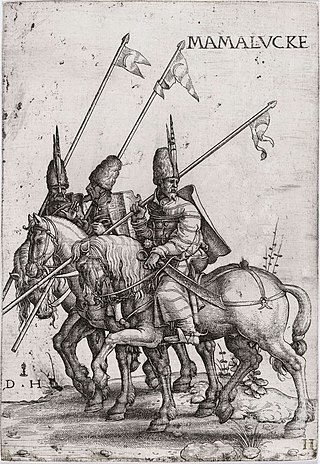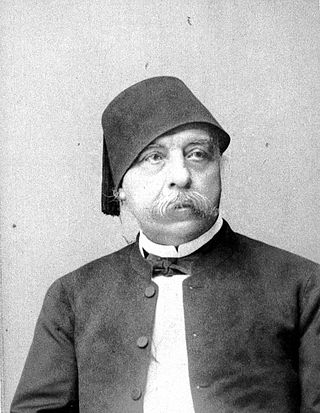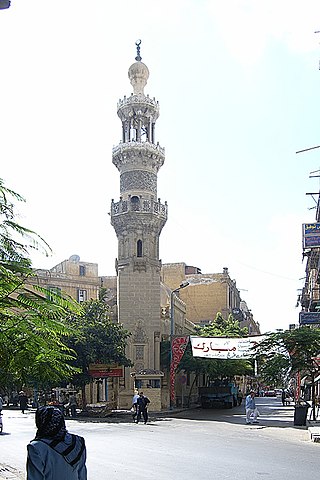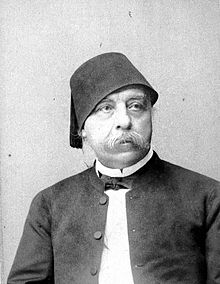
Cairo is the capital of Egypt and the city-state Cairo Governorate, and is the country's largest city, home to 10 million people. It is also part of the largest urban agglomeration in Africa, the Arab world and the Middle East: The Greater Cairo metropolitan area is the 12th-largest in the world by population with a population of over 22.1 million.

The Fatimid Caliphate or Fatimid Empire was a caliphate extant from the tenth to the twelfth centuries CE under the rule of the Fatimids, an Isma'ili Shia dynasty. Spanning a large area of North Africa and West Asia, it ranged from the western Mediterranean in the west to the Red Sea in the east. The Fatimids trace their ancestry to the Islamic prophet Muhammad's daughter Fatima and her husband Ali, the first Shia imam. The Fatimids were acknowledged as the rightful imams by different Isma‘ili communities as well as by denominations in many other Muslim lands and adjacent regions. Originating during the Abbasid Caliphate, the Fatimids conquered Ifriqiya and established the city of al-Mahdiyya. The Fatimid dynasty ruled territories across the Mediterranean coast and ultimately made Egypt the center of the caliphate. At its height, the caliphate included—in addition to Egypt—varying areas of the Maghreb, Sicily, the Levant, and the Hejaz.

Mamluk or Mamaluk were non-Arab, ethnically diverse enslaved mercenaries, slave-soldiers, and freed slaves who were assigned high-ranking military and administrative duties, serving the ruling Arab and Ottoman dynasties in the Muslim world.

Nubar Pasha was an Egyptian-Armenian politician and the first Prime Minister of Egypt. He served as Prime Minister three times during his career. His first term was between August 1878 and 23 February 1879. His second term was served from 10 January 1884 to 9 June 1888. His final term was between 16 April 1894 and 12 November 1895.

The Bahri Mamluks, sometimes referred to as the Bahri dynasty, were the rulers of the Mamluk Sultanate of Egypt from 1250 to 1382, following the Ayyubid dynasty. The members of the Mamluk ruling class were purchased as slaves (mamluks) and manumitted, with the most powerful among them taking the role of sultan in Cairo. While several Bahri Mamluk sultans tried to establish hereditary dynasties through their sons, these attempts were ultimately unsuccessful, with the role of sultan often passing on to another powerful Mamluk.

Al-Ashraf Salāh ad-Dīn Khalil ibn Qalawūn was the eighth Turkic Bahri Mamluk sultan, succeeding his father Qalawun. He served from 12 November 1290 until his assassination in December 1293. He was well known for conquering the last of the Crusader states in Palestine after the siege of Acre in 1291. While walking with a friend, Khalil was attacked and assassinated by Baydara and his followers, who was then killed under the orders of Kitbugha.

Islamic Cairo, or Medieval Cairo, officially Historic Cairo, refers mostly to the areas of Cairo, Egypt, that were built from the Muslim conquest in 641 CE until the city's modern expansion in the 19th century during Khedive Ismail's rule, namely: the central parts within the old walled city, the historic cemeteries, the area around the Citadel of Cairo, parts of Bulaq, and Old Cairo which dates back to Roman times and includes major Coptic Christian monuments.

The Armenian General Benevolent Union is a non-profit Armenian organization established in Cairo, Egypt, in 1906. With the onset of World War II, headquarters were moved to New York City, New York.
Pope Athanasius III of Alexandria, 76th Pope of Alexandria and Patriarch of the See of St. Mark.

Heliopolis was an early 20th century suburb outside Cairo, Egypt, which has since merged with Cairo and is administratively divided into the districts of Masr El Gedida and El Nozha in the Eastern Area.

Abū'l-Najm Badr ibn ʿAbdallāh al-Jamālī al-Mustanṣirī, better known as Badr al-Jamali, was a vizier and prominent statesman for the Fatimid Caliphate under Caliph al-Mustansir. His appointment to the vizierate in 1073 restored the fortunes of the Fatimid state, which had faced collapse in the previous decades, but also began a period where the vizierate was dominated by military strongmen who held power through their military strength, rather than through the Caliph's appointment. An Armenian Badr al-Jamali initiated a wave of Armenian migration into Egypt, and was the first of a series of viziers of Armenian origin, who played a major role in the fortunes of the Fatimid Caliphate over the subsequent century.

Boghos Nubar, also known as Boghos Nubar Pasha, was the son of Nubar Pasha, a three time governor of Egypt. A chairman of the Armenian National Delegation, and the founder, alongside ten other Armenian national movement leaders, of the Armenian General Benevolent Union (AGBU) on April 15, 1906, becoming its first ever president, a position he held from 1906 to 1928.

Kalousdian Armenian School was established in 1854 by Garabed Agha Kaloustian. The school is the oldest standing institution of private education in Egypt and the oldest standing Armenian educational institution in Egypt.

Nubarashen, is one of the 12 districts of Yerevan, the capital of Armenia. It is situated at the southeastern part of the city. It is bordered by Shengavit and Erebuni districts from the north, and Ararat Province from the east, south and west.

Armenian Uruguayans number around 15,000–20,000 of the population, making Uruguay to have one of the largest Armenian populations around the world. The Armenian community in Uruguay is one of the oldest communities in South America, with most of them residing in the capital Montevideo. The majority of Armenians in Uruguay are either third or fourth-generation descendants of the first wave of immigrants coming from the Ottoman Empire between the end of the 19th century and the Armenian genocide.
Zareh Nubar was son of Boghos Nubar, the founder of the Armenian General Benevolent Union (AGBU) and grandson of the Egyptian Prime Minister Nubar Pasha.
Atsiz ibn Uwaq al-Khwarizmi, also known as al-Aqsis, Atsiz ibn Uvaq, Atsiz ibn Oq and Atsiz ibn Abaq, was a Turkoman mercenary commander who established a principality in Palestine and southern Syria after seizing these from the Fatimid Caliphate in 1071.

The al-Sayyida Nafisa Mosque is a mosque in al-Sayyida Nafisa district, a section of the larger historic necropolis called al-Qarafa in Cairo, Egypt. It is built to commemorate Sayyida Nafisa, an Islamic saint and member of the family of the Islamic prophet Muhammad. The mosque contains her mausoleum, also known as a mashhad. She was the great-granddaughter of Hasan, one of the Prophet Muhammad's two grandsons. Along with the necropolis around it, the mosque is listed as part of the UNESCO World Heritage Site of Historic Cairo.

The Attarine Mosque, also known as the Al-Juyushi Mosque is a historic mosque located in Alexandria, Egypt. It was built on the site of a former church dedicated to Athanasius of Alexandria which was later dedicated to Saint Sabbas. The present structure of the mosque dates back to the early 20th century, and much of its original foundation has been lost, save for an inscription on a stone which commemorates Badr al-Jamali, one of the renovators of the mosque.




















